Empirical Model for Evaluating PM10 Concentration Caused by River Dust Episodes
Abstract
:1. Introduction
Highlights
- Most river dust has a particle size of PM10. The relationship between PM10 concentration and meteorological factors or bare land area can be used to construct an early warning system for river dust episodes.
- Air quality monitoring stations are typically not located in areas with river dust emission. Therefore, a time lag effect existed between meteorological factors and PM10 concentration. This effect can be used for early warnings of river dust episodes.
- In early winter, a positive correlation existed between bare land area and PM10 concentrations, but this relationship was not statistically significant in late winter. The primary reason is that the coarse earth and sand particles of the bare land create a protective armoring that decreases PM10 concentrations.
2. Materials and Methods
2.1. Study Area
2.2. Materials
2.3. Methods
2.3.1. Screening for Days with River Dust Episodes
- ①
- From monitoring station logs, find days with PM10 episodes (defined as days when the average PM10 concentration was greater than or equal to 125 μg/m3).
- ②
- Exclude all days with dust storms and/or rainfall.
- ③
- Obtain the annual average wind velocity and the daily average wind velocity for all remaining days. For a given day, if the daily average wind velocity is higher than the annual average wind velocity, then that day is temporarily defined as being a river dust episode.
- ④
- For a day temporarily defined as being a river dust episode, if the ratio of (PM10−PM2.5)/PM10 is greater than 0.4, and either the daily average wind velocity or the mid-day (12:00–17:00) average wind velocity is greater than 2 m/s, then that day is confirmed as being a river dust episode.
- ⑤
- For all remaining days, if the ratio of (PM10−PM2.5)/PM10 is greater than 0.4, and either the daily average wind velocity or the mid-day (12:00–17:00) average wind velocity is greater than 3 m/s, then that day is redefined as being a river dust episode.
- ⑥
- River dust episodes mostly occur during the northeastern monsoon season and the Lun-Bei Station is located slightly to the west of the south bank of the Zhuo-Shui River. Thus, the dust primarily comes from the northeastern direction. Among the above results, days without a northeastern wind need to be excluded. Wind direction is defined as the sum of all wind vectors at the time when PM10 is greater than 125 μg/m3. If the result falls in the first quadrant, then the wind is defined as a northeastern wind.
2.3.2. Image Classification
2.3.3. Accuracy Assessment of Kappa Coefficient
2.3.4. Multiple Regression Analysis
3. Results
3.1. Relationships between PM10 Concentration and Meteorological Factors
3.2. Relationships between PM10 Concentration and Bare Land Area
4. Discussion
5. Validation
6. Conclusions
Acknowledgments
Author Contributions
Conflicts of Interest
References
- Pope, C.A. Epidemiology of fine particulate air pollution and human health: Biologic mechanisms and who’s at risk? Environ. Health Perspect. 2000, 108, 713–723. [Google Scholar] [CrossRef] [PubMed]
- Li, C.; Hsu, N.C.; Tsay, S.C. A study on the potential applications of satellite data in air quality monitoring and forecasting. Atmos. Environ. 2011, 45, 3663–3675. [Google Scholar] [CrossRef]
- Shahraiyni, T.H.; Sodoudi, S. Statistical modeling approaches for PM10 prediction in urban areas; A review of 21st-century studies. Atmosphere (Basel) 2016, 7, 15. [Google Scholar] [CrossRef]
- Zickus, M.; Greig, A.J.; Niranjan, M. Comparison of four machine learning methods for predicting PM10 concentrations in Helsinki, Finland. Water Air Soil Pollut. Focus 2002, 2, 717–729. [Google Scholar] [CrossRef]
- Goyal, P.; Chan, A.T.; Jaiswal, N. Statistical models for the prediction of respirable suspended particulate matter in urban cities. Atmos. Environ. 2006, 40, 2068–2077. [Google Scholar] [CrossRef]
- Chen, Y.; Shi, R.; Shu, S.; Gao, W. Ensemble and enhanced PM10 concentration forecast model based on stepwise regression and wavelet analysis. Atmos. Environ. 2013, 74, 346–359. [Google Scholar] [CrossRef]
- Ul-Saufie, A.Z.; Yahaya, A.S.; Ramli, N.A.; Rosaida, N.; Hamid, H.A. Future daily PM10 concentrations prediction by combining regression models and feedforward backpropagation models with principle component analysis (PCA). Atmos. Environ. 2013, 77, 621–630. [Google Scholar] [CrossRef]
- Dimitriou, K.; Kassomenos, P. A study on the reconstitution of daily PM10 and PM2.5 levels in Paris with a multivariate linear regression model. Atmos. Environ. 2014, 98, 648–654. [Google Scholar] [CrossRef]
- Benas, N.; Beloconi, A.; Chrysoulakis, N. Estimation of urban PM10 concentration, based on MODIS and MERIS/AATSR synergistic observations. Atmos. Environ. 2013, 79, 448–454. [Google Scholar] [CrossRef]
- Seo, S.; Kim, J.; Lee, H.; Jeong, U.; Kim, W.; Holben, B.N.; Kim, S.W.; Song, C.H.; Lim, J.H. Estimation of PM10 concentrations over Seoul using multiple empirical models with AERONET and MODIS data collected during the DRAGON-Asia campaign. Atmos. Chem. Phys. 2015, 15, 319–334. [Google Scholar] [CrossRef]
- Barmpadimos, I.; Hueglin, C.; Keller, J.; Henne, S.; Prévôt, A.S.H. Influence of meteorology on PM10 trends and variability in Switzerland from 1991 to 2008. Atmos. Chem. Phys. 2011, 11, 1813–1835. [Google Scholar] [CrossRef]
- Gupta, P.; Christopher, S.A. Particulate matter air quality assessment using integrated surface, satellite, and meteorological products: Multiple regression approach. J. Geophys. Res. Atmos. 2009, 114, 1–13. [Google Scholar] [CrossRef]
- You, W.; Zang, Z.; Zhang, L.; Li, Z.; Chen, D.; Zhang, G. Estimating ground-level PM10 concentration in northwestern China using geographically weighted regression based on satellite AOD combined with CALIPSO and MODIS fire count. Remote Sens. Environ. 2015, 168, 276–285. [Google Scholar] [CrossRef]
- Lawrence, C.R.; Neff, J.C. The contemporary physical and chemical flux of aeolian dust: A synthesis of direct measurements of dust deposition. Chem. Geol. 2009, 267, 46–63. [Google Scholar] [CrossRef]
- Pye, K. Chapter four—Dust sources, sinks and rates of deposition. In Aeolian Dust and Dust Deposits; Academic Press: Cambridge, MA, USA, 1987; pp. 63–91. [Google Scholar]
- Lin, C.Y.; Tsai, S.F.; Chuang, C.W. Delineation and management of dust emission potential areas on riverbed. J. Chin. Soil Water Conserv. 2008, 39, 367–377. [Google Scholar]
- Lin, C.Y.; Chang, M.L.; Chuang, C.W. Effects of aeolian dust on the fine airborne particles (PM10) at the estuary of Zhuoshui River. J. Soil Water Conserv. 2009, 41, 285–296. [Google Scholar]
- Chiu, Y.H.; Chuang, C.W.; Lin, C.Y. Delineating potential areas of aeolian dust occurrence with edge detection techniques in the Jhuoshei River. J. Chin. Soil Water Conserv. 2011, 42, 107–119. [Google Scholar]
- Lin, C.Y.; Lin, C.Y. Factors affecting aeolian dust emission in the downstream of Zhuo-Shui River. J. Chin. Soil Water Conserv. 2012, 43, 323–331. [Google Scholar]
- Huang, L.M.; Chen, T.C.; Fan-Jiang, M.W. Investigation and study of aeolian sand and fugitive dust on the coastal area in central Taiwan. J. Soil Water Conserv. 2011, 43, 259–276. [Google Scholar]
- Monn, C.H.; Braendli, O.; Schaeppi, G.; Schindler, C.H.; Liebrich, U.A.; Leuenbrger, P.H.; Team, S. Particulate matter <10 μm (PM10) and total suspended particulates (TSP) in urban, rural and alpine air in Switzerland. Atmos. Environ. 1995, 29, 2565–2573. [Google Scholar]
- Yu, K.J. Numerical Simulation on Suspended Fine Particulate PM10 of Fugitive Dust at Ta-An River Near Estuary. Master’s Thesis, Department of Civil Engineering, National Chung Hsing University, Taichung, Taiwan, 20 July 2010. [Google Scholar]
- Lin, H.W. Characteristics and Re-Suspension Evaluation of River Fugitive Dust—A Field Study in Chunghua County. Master’s Thesis, Department of Occupational Safety and Health, Chung Shan Medical University, Taichung, Taiwan, 31 July 2013. [Google Scholar]
- Chan, J.N. The Analysis of PM10 Air Pollution Problem in Taiwan Area. Master’s Thesis, Graduate Institute of Environmental Engineering, National Taiwan University, Taipei, Taiwan, 1996. [Google Scholar]
- Chu, S.H. Meteorological factors conducive to regional high particulate matter episodes. In Proceedings of the Air and Waste Management Association’s 90th Annual Meeting and Exhibition, Toronto, ON, Canada, 8–13 June 1997.
- Smith, S.; Stribley, F.T.; Milligan, P.; Barratt, B. Factors influencing measurements of PM10 during 1995–1997 in London. Atmos. Environ. 2001, 35, 4651–4662. [Google Scholar] [CrossRef]
- Tegen, I.; Harrison, S.P.; Kohfeld, K.; Prentice, I.C.; Coe, M.; Heimann, M. Impact of vegetation and preferential source areas on global dust aerosol: Results from a model study. J. Geophys. Res. Atmos. 2002, 107, 14–27. [Google Scholar] [CrossRef]
- Kim, D.; Chin, M.; Bian, H.; Tan, Q.; Brown, M.E.; Zheng, T.; You, R.; Dieh, T.; Ginoux, P.; Kucsera, T. The effect of the dynamic surface bareness on dust source function, emission, and distribution. J. Geophys. Res. Atmos. 2013, 118, 871–886. [Google Scholar] [CrossRef]
- Chen, W.; Zhibao, D.; Zhenshan, L.; Zuotao, Y. Wind tunnel test of the influence of moisture on the erodibility of loessial sandy loam soils by wind. J. Arid Environ. 1996, 34, 391–402. [Google Scholar] [CrossRef]
- Yap, X.Q.; Hashim, M. A robust calibration approach for PM10 prediction from MODIS aerosol optical depth. Atmos. Chem. Phys. 2013, 13, 3517–3526. [Google Scholar] [CrossRef]
- Hoek, G.; Beelen, R.; de Hoogh, K.; Vienneau, D.; Gulliver, J.; Fischer, P.; Briggs, D. A review of land-use regression models to assess spatial variation of outdoor air pollution. Atmos. Environ. 2008, 42, 7561–7578. [Google Scholar] [CrossRef]
- Vienneau, D.; de Hoogh, K.; Beelen, R.; Fischer, P.; Hoek, G.; Briggs, D. Comparison of land-use regression models between Great Britain and the Netherlands. Atmos. Environ. 2010, 44, 688–696. [Google Scholar] [CrossRef]
- Sun, L.; Wei, J.; Duan, D.H.; Guo, Y.M.; Yang, D.X.; Jia, C.; Mi, X.T. Impact of land-use and land-cover change on urban air quality in representative cities of China. J. Atmos. Sol.-Terr. Phys. 2016, 142, 43–54. [Google Scholar] [CrossRef]
- Xu, G.; Jiao, L.; Zhao, S.; Yuan, M.; Li, X.; Han, Y.; Zhang, B.; Dong, T. Examining the impacts of land use on air quality from a spatio-temporal perspective in Wuhan, China. Atmosphere (Basel) 2016, 7, 62. [Google Scholar] [CrossRef]
- Chen, T.S. Remote sensing analyses for the land-cover changes in the coastal zone of the Choshuiestuary. Endem. Species Res. 2003, 5, 61–72. [Google Scholar]
- Environmental Protection Administration, Executive Yuan, R.O.C. Taiwan Air Quality Monitoring Network. Available online: http://taqm.epa.gov.tw/taqm/en/Site/Lunbei.aspx (accessed on 25 April 2016).
- Environmental Protection Administration. The Assessment Project of the Effect of Particulate Matter by Aeolian Dust Emission in Central Taiwan; The Research Project of Environmental Protection Administration Executive Yuan; Environmental Protection Administration: Taipei, Taiwan, 2008.
- Kuo, C.Y.; Chen, P.T.; Lin, Y.C.; Chen, H.H.; Shih, J.F.; Lin, C.Y. Factors affecting the concentrations of PM10 in central Taiwan. Chemosphere 2008, 70, 1273–1279. [Google Scholar] [CrossRef] [PubMed]
- Jensen, J.R. Introductory Digital Image Processing: A Remote Sensing Perspective, 2nd ed.; Prentice-Hall: Upper Saddle River, NJ, USA, 1996. [Google Scholar]
- Lillesand, T.M.; Kiefer, R.W. Remote Sensing and Image Interpretation; John Wiley & Sons, Inc.: Hoboken, NJ, USA, 1994; pp. 15–592. [Google Scholar]
- Congalton, R.G. A review of assessing the accuracy of classifications of remotely sensed data. Remote Sens. Environ. 1991, 37, 35–46. [Google Scholar] [CrossRef]
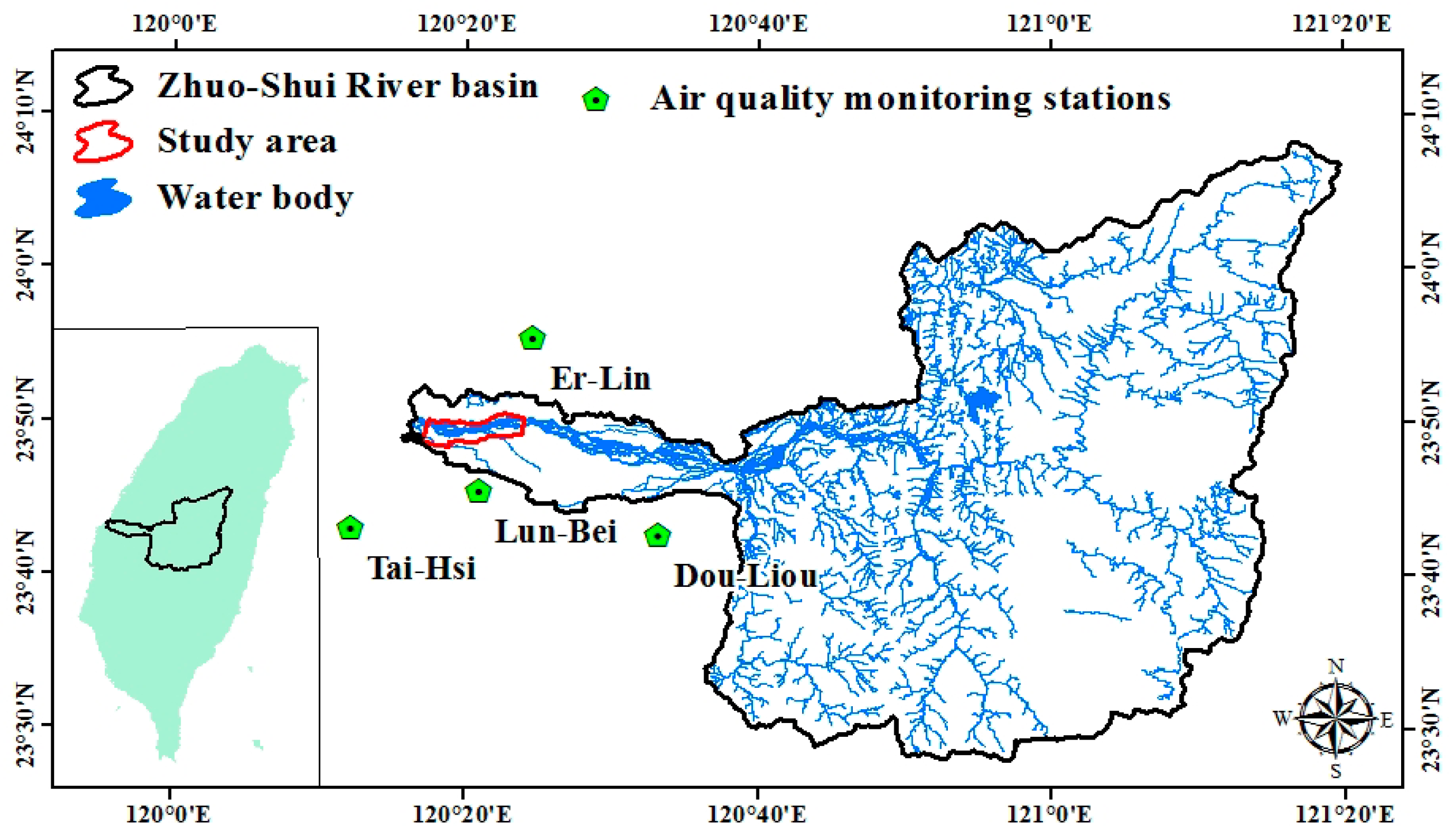
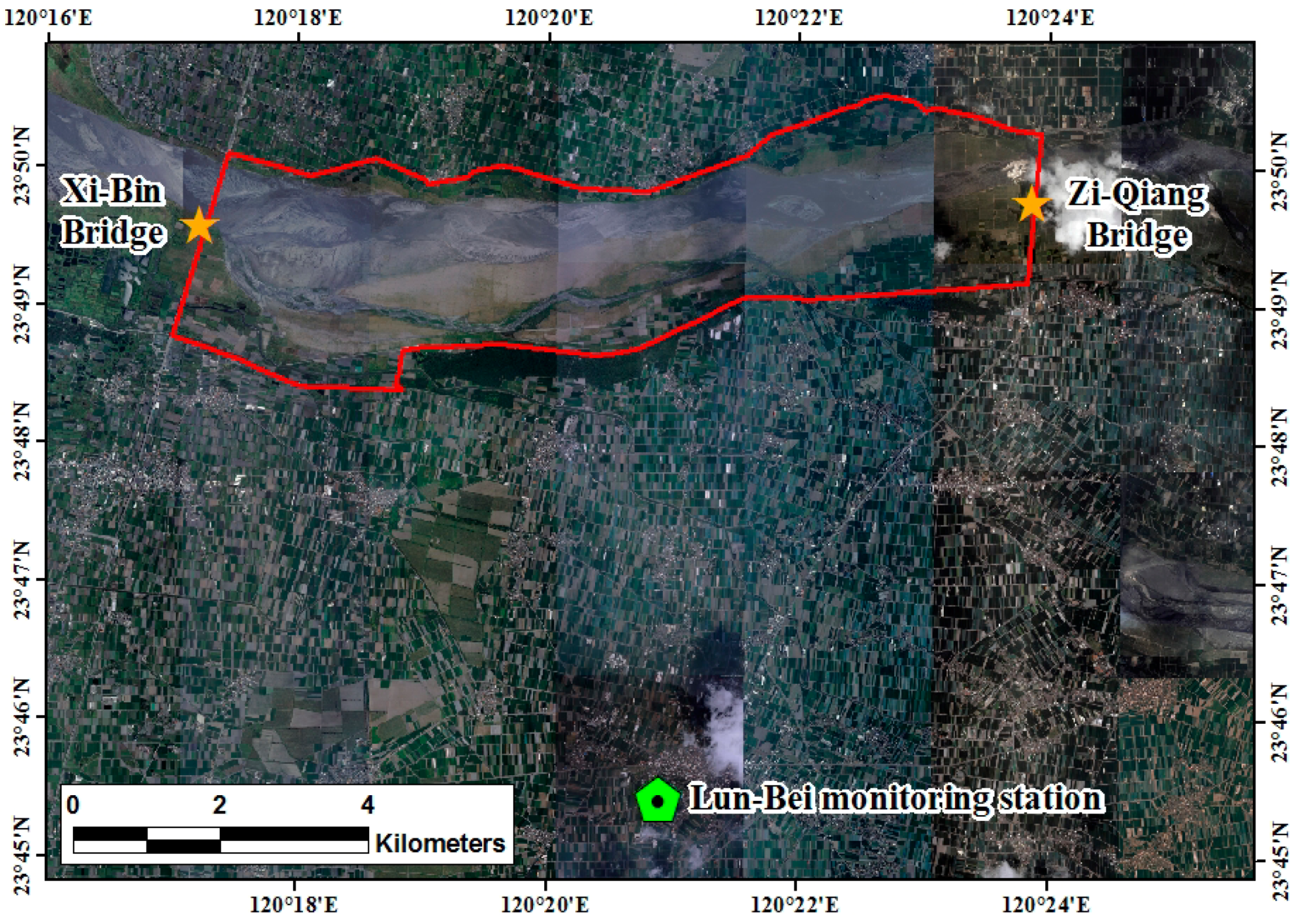

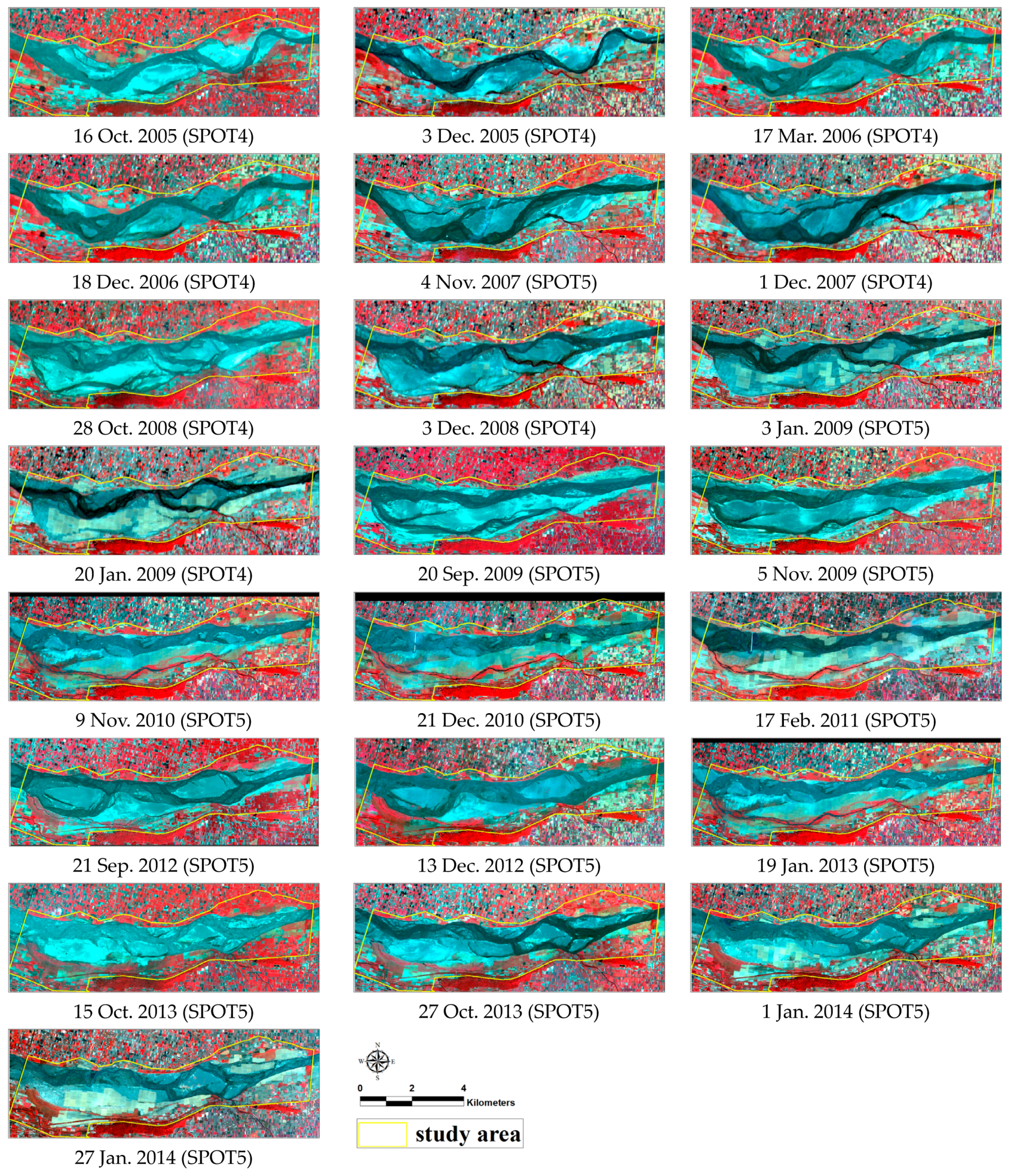
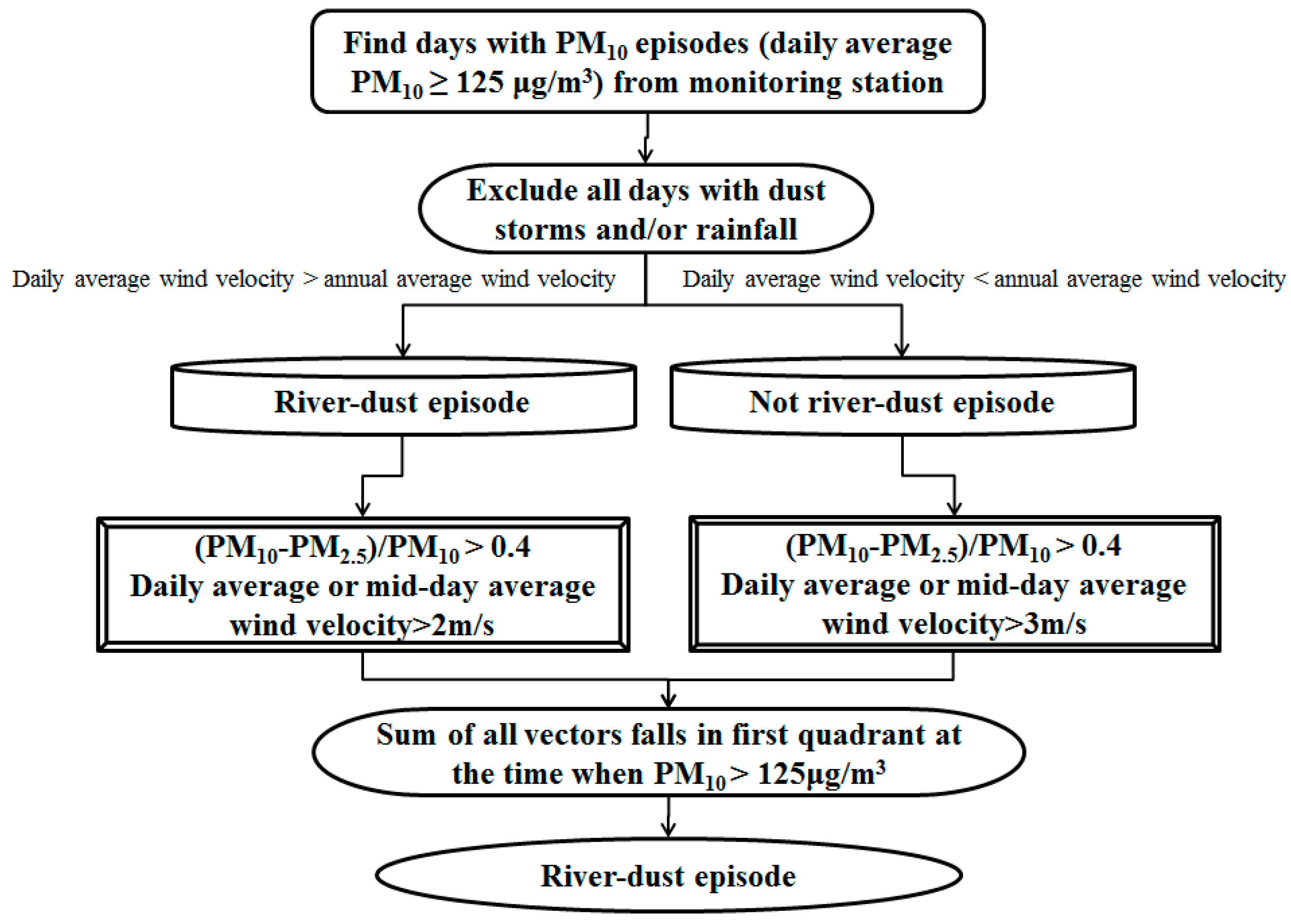
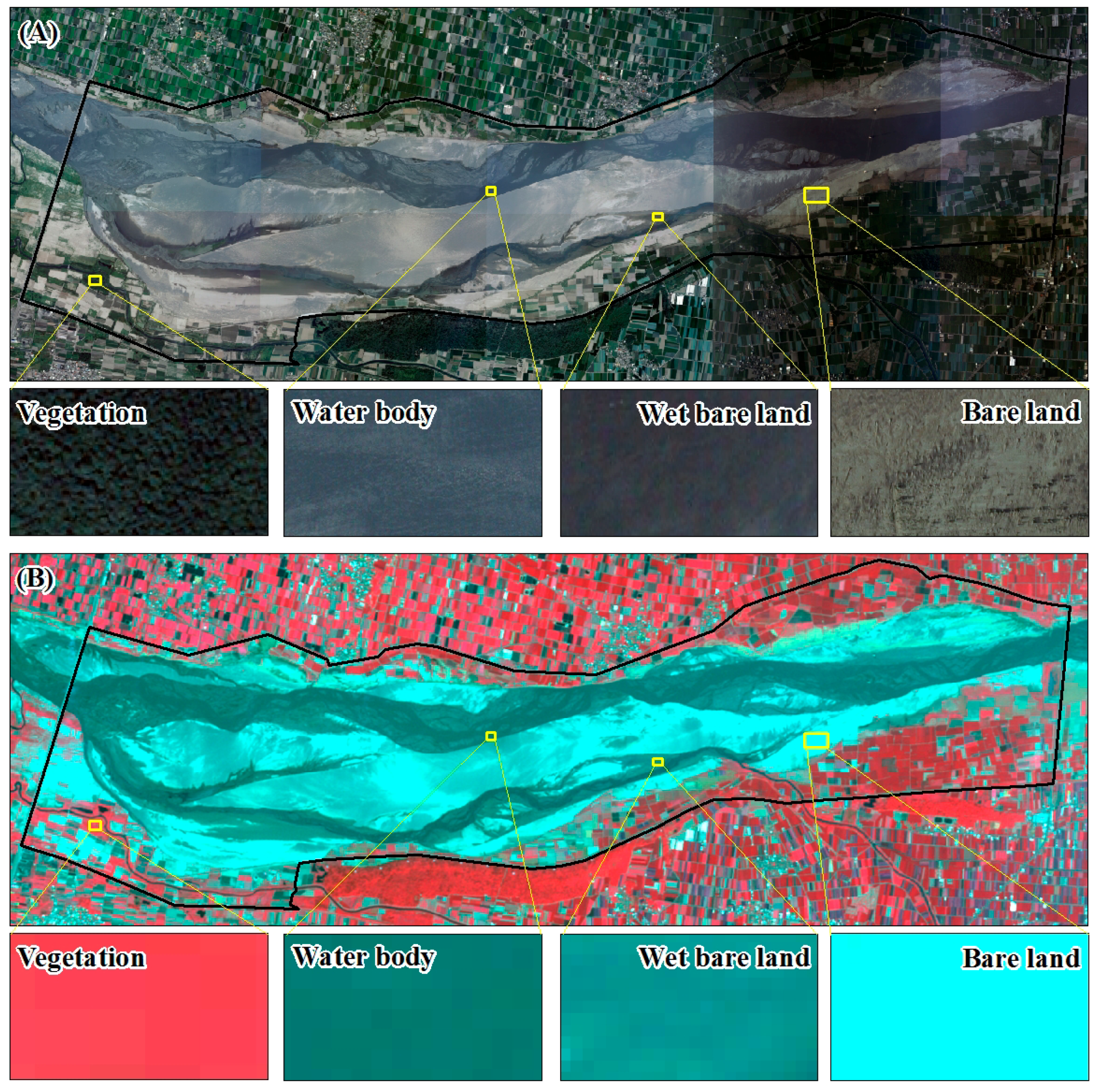
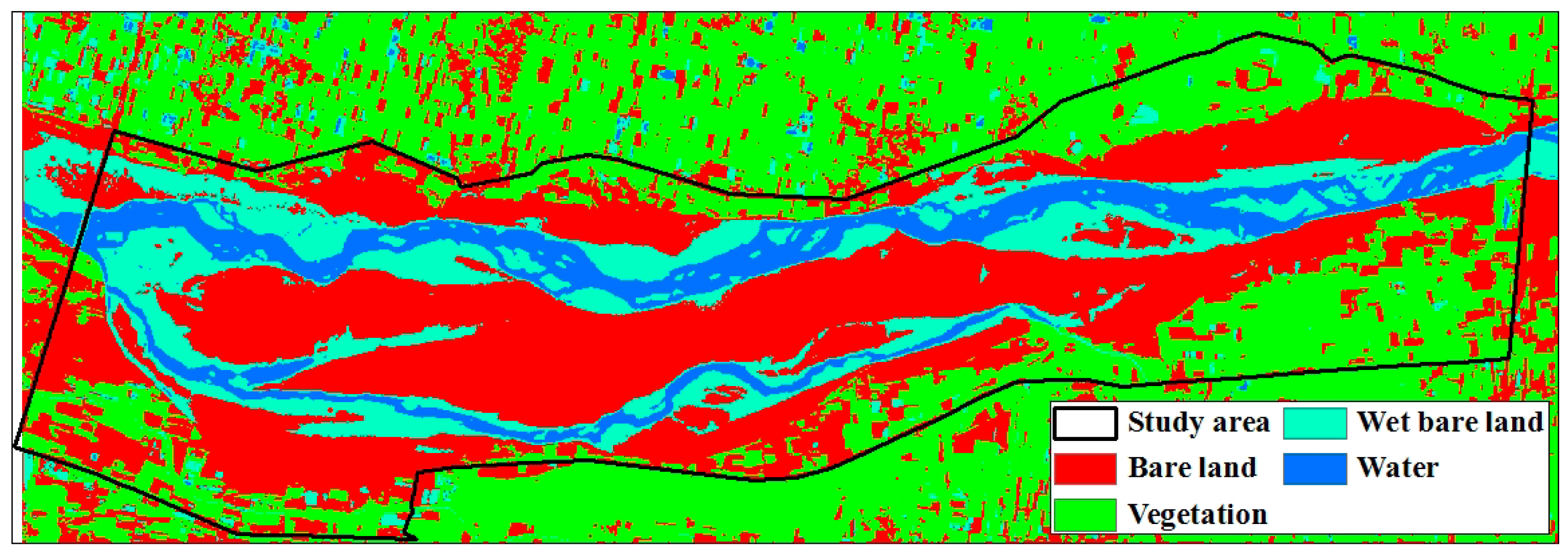
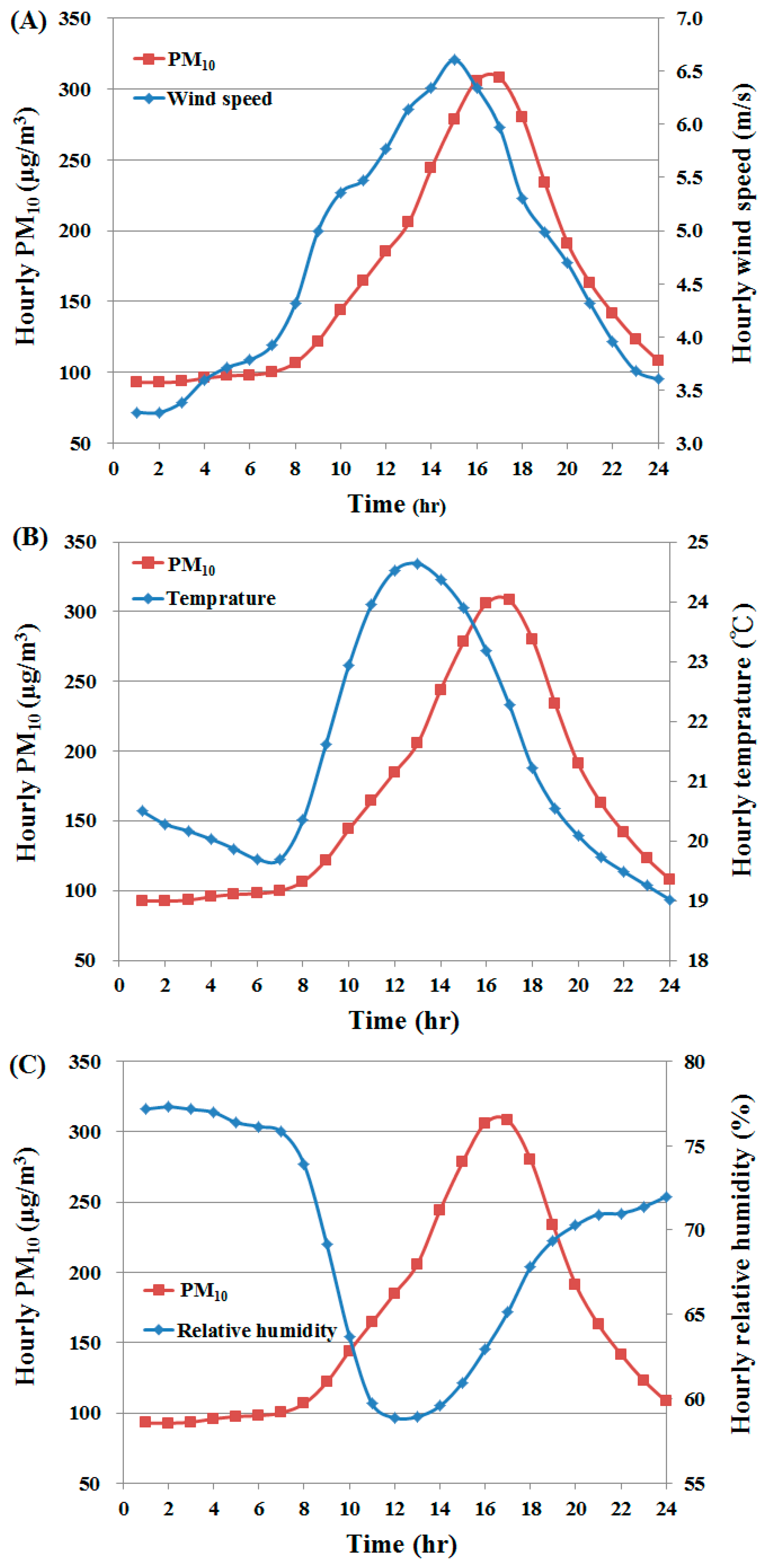
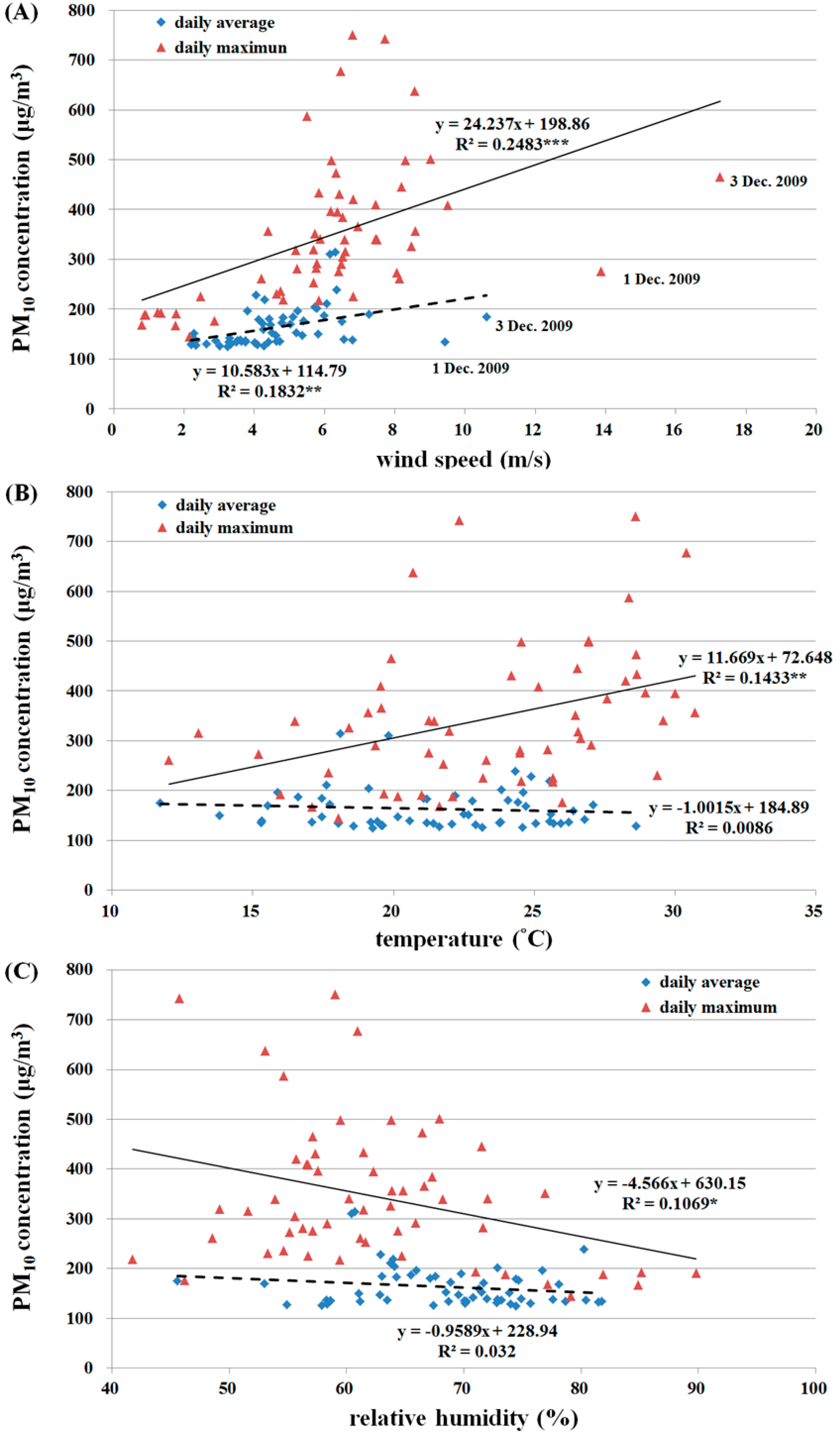

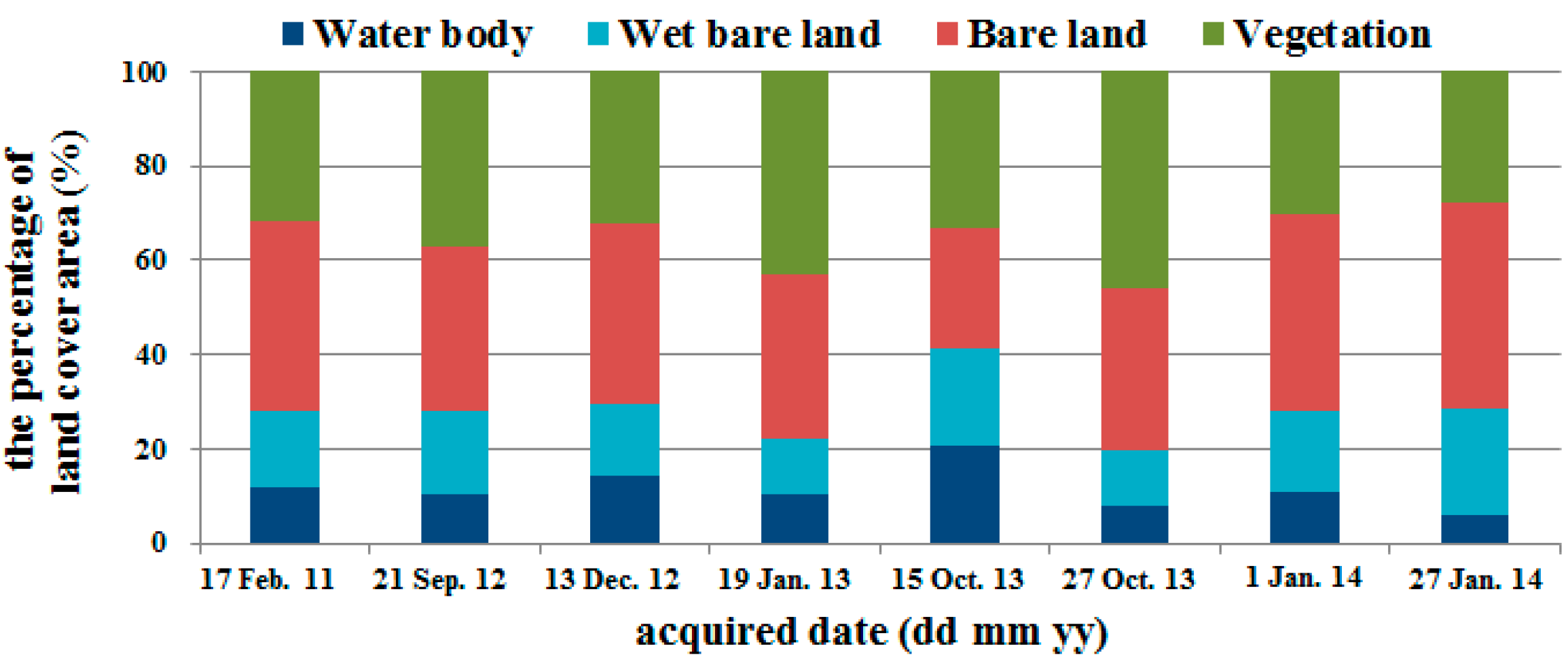
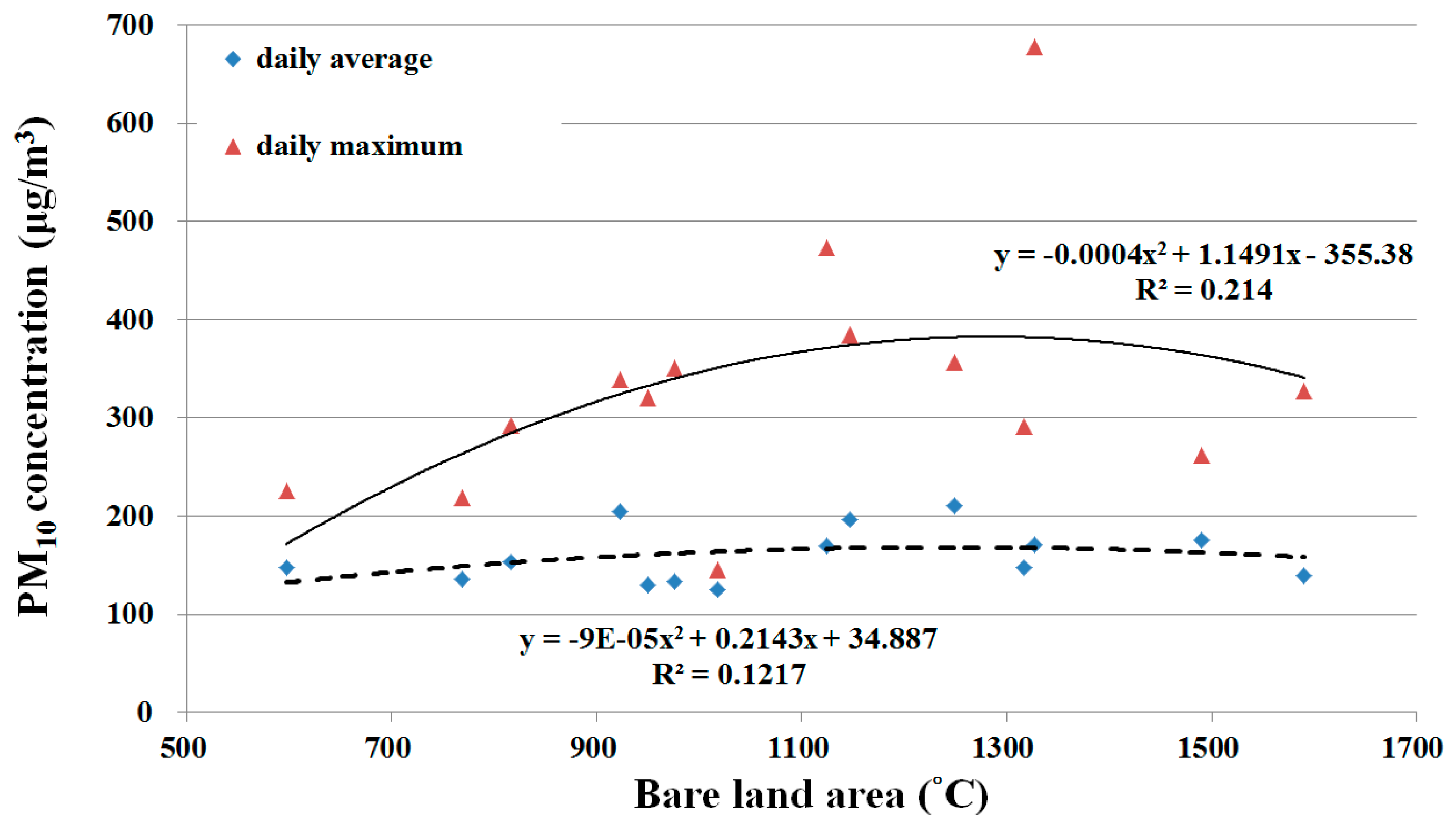
| Model | Items | Number of Records | Equations | R2 |
|---|---|---|---|---|
| 1 | Daily Average | 57 | PM10 = 11.82 WD + 110.46 | 0.202 *** |
| 2 | Daily Maximum | 57 | PM10 = 24.37 WH-2h + 11.78 TH-2h − 76.63 | 0.394 *** |
| 3 | Daily Maximum | 14 | PM10 = 35.69 WH-2h + 17.62 TH-2h + 0.08Abare − 363.98 | 0.67 ** |
| Date (dd mm yy) | Daily Average PM10 Validation | Daily Maximum PM10 Validation | ||||
|---|---|---|---|---|---|---|
| Actual PM10 | Predicted PM10 | Percent Error | Actual PM10 | Predicted PM10 | Percent Error | |
| 9 Feb. 2011 | 133 | 147 | 10.59 | 188 | 312 | 65.75 |
| 14 Sep. 2012 | 190 | 163 | −14.08 | 461 | 467 | 1.24 |
| 15 Sep. 2012 | 151 | 179 | 18.94 | 425 | 457 | 7.62 |
| 28 Sep. 2012 | 272 | 198 | −27.23 | 548 | 432 | −21.20 |
| 23 Dec. 2012 | 135 | 189 | 39.42 | 318 | 307 | −3.42 |
| 17 Jan. 2013 | 153 | 178 | 16.28 | 358 | 355 | −0.71 |
| 6 Mar. 2013 | 125 | 132 | 5.77 | 158 | 165 | 4.18 |
| 3 Oct. 2013 | 147 | 161 | 9.45 | 253 | 352 | 39.06 |
| 5 Oct. 2013 | 167 | 171 | 2.15 | 497 | 448 | −9.85 |
| 23 Oct. 2013 | 141 | 170 | 20.10 | 375 | 431 | 15.04 |
| 24 Oct. 2013 | 207 | 179 | −13.61 | 471 | 413 | −12.37 |
| 25 Oct. 2013 | 185 | 170 | −8.31 | 342 | 331 | −3.19 |
| 27 Dec. 2013 | 230 | 184 | −19.96 | 355 | 266 | −25.15 |
| 4 Jan. 2014 | 164 | 155 | −5.61 | 266 | 283 | 6.46 |
| 5 Jan. 2014 | 159 | 148 | −6.94 | 203 | 185 | −8.92 |
| 14 Jan. 2014 | 141 | 185 | 31.39 | 371 | 340 | −8.24 |
| 18 Jan. 2014 | 263 | 184 | −30.16 | 680 | 319 | −53.16 |
| Date (dd mm yy) | Date of Satellite Image (dd mm yy) | Actual PM10 | Predicted PM10 | Percent Error |
|---|---|---|---|---|
| 9 Feb. 2011 | 17 Feb. 2011 | 188 | 298 | 58.42 |
| 28 Sep. 2012 | 21 Sep. 2012 | 548 | 464 | −15.31 |
| 23 Dec. 2012 | 13 Dec. 2012 | 318 | 285 | −10.48 |
| 17 Jan. 2013 | 19 Jan. 2013 | 358 | 348 | −2.66 |
| 5 Oct. 2013 | 15 Oct. 2013 | 497 | 468 | −5.77 |
| 25 Oct. 2013 | 27 Oct. 2013 | 342 | 314 | −8.15 |
| 4 Jan. 2014 | 1 Jan. 2014 | 266 | 259 | −2.55 |
| 18 Jan. 2014 | 27 Jan. 2014 | 680 | 314 | −53.85 |
© 2016 by the authors; licensee MDPI, Basel, Switzerland. This article is an open access article distributed under the terms and conditions of the Creative Commons Attribution (CC-BY) license (http://creativecommons.org/licenses/by/4.0/).
Share and Cite
Lin, C.-Y.; Chiang, M.-L.; Lin, C.-Y. Empirical Model for Evaluating PM10 Concentration Caused by River Dust Episodes. Int. J. Environ. Res. Public Health 2016, 13, 553. https://doi.org/10.3390/ijerph13060553
Lin C-Y, Chiang M-L, Lin C-Y. Empirical Model for Evaluating PM10 Concentration Caused by River Dust Episodes. International Journal of Environmental Research and Public Health. 2016; 13(6):553. https://doi.org/10.3390/ijerph13060553
Chicago/Turabian StyleLin, Chao-Yuan, Mon-Ling Chiang, and Cheng-Yu Lin. 2016. "Empirical Model for Evaluating PM10 Concentration Caused by River Dust Episodes" International Journal of Environmental Research and Public Health 13, no. 6: 553. https://doi.org/10.3390/ijerph13060553
APA StyleLin, C.-Y., Chiang, M.-L., & Lin, C.-Y. (2016). Empirical Model for Evaluating PM10 Concentration Caused by River Dust Episodes. International Journal of Environmental Research and Public Health, 13(6), 553. https://doi.org/10.3390/ijerph13060553





